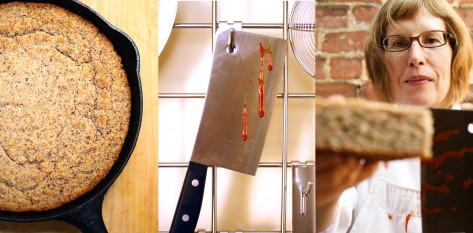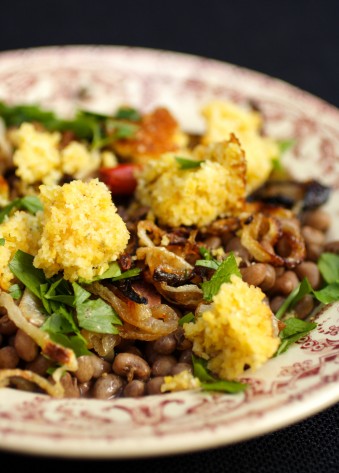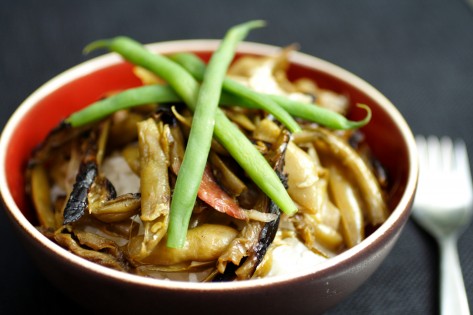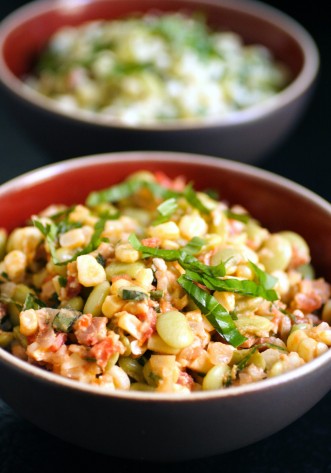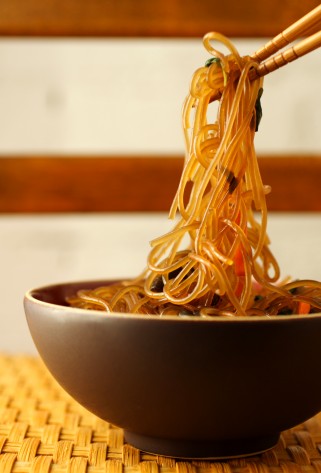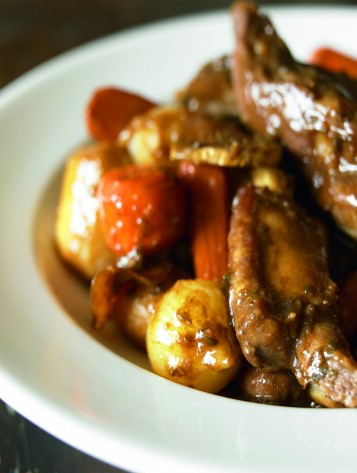
photo by Heath Robbins
Have you ever sat back in your chair after enjoying a meal, allowing the flavors to linger in your mouth, reached for your water glass, and then regretted it? I have, until breaking myself of the habit. All it takes is one small sip of water to wash all of those wonderful flavors down the tubes, possibly never to be experienced again in exactly the same way.
This dish from The Korean Table, or rather its redolent sauce, which is the dish, is worthy of regret—should you lapse into knee-jerk mode and imbibe in a post-meal drink of H2O.
The base of the sauce is Sweet Soy Base Sauce, a soy sauce concoction that’s ramped up with brown sugar, wine, and aromatics (ginger, garlic, and black peppercorns). To that is added more wine and black pepper and a good amount of ginger and green onions. Then in go the pork ribs, carrots, pearl onions, and potatoes. The result is a rich, mellow, and well-balanced sauce that hits all the right notes: salt, sweet, acid, faintly peppery.
Soy sauce along with the pork supply the sauce with its umami, so it’s important to use good quality pork (translation: happy life, good diet, least stressful death possible). (I kinda hate throwing the term umami around because it’s an abstract one—like a lot of food flavor language—and most of the time I’m not exactly sure I could recognize it on my palate if I had to. But every so often I eat something that seems designed just to illustrate umami. And this is one of those foods. It’s deeply rich, complex, and satisfying in a completing savory way, and yet is as addictive as a sugary treat was to you as a kid—remember picking chunks of brown sugar out of the box as a kid? As far as I can tell, that’s umami. Scientifically, umami is provided by the amino acid glutamate, found in proteins, fermented foods of all types, and some vegetables.)
I shopped for pork ribs at my new local butcher shop—the Belmont Butchery, owned by Tanya Cauthen. When the man behind the counter handed me the ribs, I was happy to see they had a nice dark and meaty color to them (none of that tragic “other white meat” business, please). He said, proudly, that the ribs were from a Berkshire pig from a local farm. His comment, and his obvious love of food and love of talking food, made me realize that the only thing that could make me happier in my new home town of Richmond is if we lived in walking distance to Belmont Butchery.
I hope my description, and the enticing photo by Heath Robbins, are enough to convince you try this dish and savor it. And to find a butcher you can talk pig breeds with. That’s as much of a treat as the dish.
Pork Ribs with Fresh Ginger
(Adapted [very slightly!] from The Korean Table by Taekyung Chung and Debra Samuels)
Serves 4, amply
2½ pounds meaty pork ribs, separated into individual ribs
2½ cups water
4 carrots, peeled and cut into 2-inch pieces
7 ounces pearl onions, peeled (see Note)
¾ pound potatoes, cut into 2-inch cubes
Sauce
¾ cup Sweet Soy Base Sauce (click here, and scroll down for recipe)
2 cups minced green onion (scallion)
2 ounces fresh ginger, peeled and thinly sliced
¼ teaspoon fresh ground black pepper
½ cup red or white wine
- Place the ribs in a large bowl and cover with water. Let them sit for 20 minutes to remove excess blood. Drain and transfer the ribs to a large pot with a lid. Discard the soaking liquid.
- Add the sauce ingredients and the water to the pot. Cover and bring the mixture to a boil. Lower the heat and simmer for 30 minutes, or until tender. Add the carrots and pearl onions and continue cooking, with the lid on, for 10 minutes. Add the potatoes can continue cooking until the vegetable are soft, about 10 minutes more.
- With a slotted spoon remove the ribs and vegetables and transfer to a serving bowl. With a spoon, skim any oil from the surface of the sauce.
- Cook the sauce for another 10 minutes or so over medium-high heat, or until the sauce is thickened. Pour the sauce over the ribs and vegetables. Serve in wide shallow soup bowls with plain white short-grain rice on the side.
Note: Peeling pearl onions is extremely finicky work, unless you give them a pre-peel blanch. Trim the root ends of the onions, then blanch the onions in boiling water for about 30 seconds and transfer them to a bowl of ice water. Pinch the onions at the stem end to pop them out of their skin. If they don’t slip out, use a paring knife to remove the skin.
(Recipes and photography from The Korean Table by Taekyung Chung and Debra Samuels. Photography by Heath Robbins. Recipe for and photograph of Pork Ribs with Fresh Ginger reprinted with the express permission of Tuttle Publishing, http://www.tuttlepublishing.com/.)
